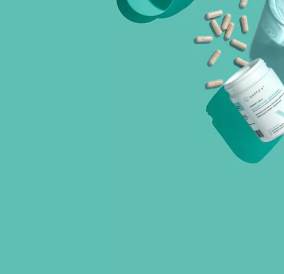- Fact Checked
- December 10, 2022
- 8 min read
Table of Contents
At first glance, bacterial vaginosis (BV) and pelvic inflammatory disease (PID) might not seem to have much in common. But the human body is complex, and when it comes to medical conditions, sometimes the connections between conditions are surprising. So what exactly is the link between BV and PID, and what should you do if you develop one of these common conditions?
What Is Bacterial Vaginosis?
Bacterial vaginosis is a type of vaginitis, or inflammation of the vagina. Around 21 million women in the U.S. have BV, although less than half of those with infections have active symptoms. (1)
BV is caused by a disturbance in the balance of natural flora in the vaginal environment. There are many different types of bacteria always present in the vagina, and on their own, these normal bacteria aren’t anything to worry about. But some conditions can disrupt the normal balance of bacteria and make it more possible for bad vaginal bacteria, also called anaerobic bacteria, to grow and thrive, which can result in a BV infection.
Symptoms of BV
About 85% percent of women with BV experience no symptoms. (2) These asymptomatic women may still be at risk of BV-associated complications such as a PID infection in women because of the presence of BV-associated bacteria in their vagina, so it’s important to get treated regularly by a women’s health care practitioner each year, even if you aren’t experiencing any symptoms.
Common signs of infection include:
- Abnormal vaginal discharge. Women with BV may notice a change in the color of their vaginal fluid. Instead of being milky white, unusual discharge may be gray in color and thin and watery.
- Abnormal vaginal odor. Some individuals with BV may notice an abnormal vaginal odor that smells foul or fishy.
- Change in vaginal pH. A healthy vagina has a vaginal pH that is slightly acidic, normally around 4.5. A BV infection can cause your vaginal pH to rise to an abnormally high level.
- Burning and irritation in or around the vagina. Many conditions can cause burning, pain, or itching around the vagina, so alone this is not a clear indication of a BV infection.
- Cramps – such as a dull, persistent ache in the lower abdomen, distinct from typical menstrual cramps
Complications of BV
Most of the time, BV does not cause serious health problems, but if neglected, it can cause serious health issues.
- Pregnancy complications. Pregnant women with BV are at an increased risk of poor pregnancy outcomes, including premature birth or having a low birth weight baby.
- Increased risk of sexually transmitted infections (STIs). Women with BV are at a higher risk of acquiring STIs such as HIV, chlamydia, and gonorrhea. This is because people with BV have a deficiency of normal bacteria that typically fight infections, making the body more susceptible to STIs.
- PID. While research is ongoing, there does seem to be a correlation between some types of bacteria that cause BV and PID infections. (3)
What Is Pelvic Inflammatory Disease?
Pelvic inflammatory disease is an upper genital tract infection that occurs in females. The genital tract includes reproductive organs such as the vagina, uterus, ovaries, and fallopian tubes. The vagina is in the lower genital tract, while the other organs compose the upper portion of the genital tract. PID occurs when sexually transmitted bacteria move from the vagina to the uterus, ovaries, or fallopian tubes. PID typically occurs in females who are sexually active between the ages of 15 and 48. About 2.5 million women in the U.S. will have PID over their lifetime. (4)
PID Symptoms
If you’re worried about developing PID, keep an eye out for the following symptoms:
- Pelvic pain. Light to mild abdominal pain is characteristic of PID.
- Unusual vaginal bleeding. Longer, heavier, or more painful periods or spotting throughout your menstrual cycle may indicate a PID infection.
- Pain during sexual intercourse. Discomfort or pain during sex can indicate PID.
- Unusual vaginal discharge. Vaginal fluid may appear yellow or greenish in color with an unusual odor.
- Painful urination. Pain, burning, or discomfort while urinating is a sign of PID as well as some other vaginal infections.
- Nausea. A feeling of nausea, a loss of appetite, and/or vomiting may suggest PID.
- Fevers. In some cases, low-grade fevers that come and go or sudden high-grade fevers with chills may be a sign of a PID infection.
Complications of PID
PID is a serious medical condition that requires treatment from a health care provider. If untreated, PID can have significant long-term consequences, including:
- Tubo-ovarian abscess. A tubo-ovarian abscess is a pocket of pus that forms because of an infection in a fallopian tube and ovary.
- Tubal factor infertility. Damage to the fallopian tubes caused by PID can increase your risk of infertility. This damage can prevent sperm from reaching the ovary to fertilize an egg or prevent a fertilized embryo from reaching the uterus to achieve pregnancy.
- Ectopic pregnancy. Having an ectopic pregnancy in which the fertilized egg implants outside the uterus is another risk of PID. An untreated ectopic pregnancy can cause serious complications for mother and baby including severe bleeding and miscarriage.
- Chronic pelvic pain. In some cases, PID can cause chronic pelvic pain that persists for 6 months or longer in the area below the belly button and between the hips.
Risk Factors for PID
Some risk factors can increase your chances of developing PID, including your age (younger people are more likely to develop PID), the use of an intrauterine device for birth control, having sexual contact with new or multiple sexual partners, douching, having unprotected sexual intercourse, and a history significant for STIs. If any of these risk factors pertain to you, share this information with your health care provider.
How Is PID Diagnosed?
Unlike many genital infections, there’s no particular test to diagnose PID. However, if you notice any signs of PID, you should seek medical attention from a health care provider. They may want to discuss your medical history, including whether you have had STIs, what birth control methods you use, and what your sexual history looks like. They may also discuss your current symptoms as well as any symptoms you’ve experienced in the past. If your provider believes you may have PID, they may do a:
- Pelvic examination. Your doctor may do a physical examination of your vagina to review your vaginal discharge and any vaginal swelling and to swab your vagina to test for different infections.
- Ultrasound. An ultrasound lets your provider review the health of your reproductive organs.
Does BV Cause PID?
Recent research shows that BV-associated organisms such as Gardnerella vaginalis and Mycoplasma hominis can cause reproductive health problems like endometritis (inflammation of the inner lining of the uterus) and salpingitis (inflammation of fallopian tubes). (5,6) These two areas are directly impacted by PID, meaning a BV infection increases your likelihood of developing PID.
As discussed above, a BV infection is caused by an overgrowth of bad bacteria. These bacteria are able to grow and cause an infection because good bacteria, called lactobacillus, is at lower-than-normal levels. When lactobacillus levels are low, the vagina is susceptible to many types of infections, including BV, STIs, and PID.
How To Prevent BV or PID

Infections like bacterial vaginosis or pelvic inflammatory disease may seem like an annoyance, but they should be treated very seriously. If they’re not taken care of, they can result in serious health outcomes, especially if you are pregnant or plan to become pregnant in the future. While there’s no foolproof way to avoid these infections entirely, try these tips to reduce your risk of BV or PID:
Get Frequent STI Testing
Get yourself frequently tested for the presence of any STI. Early identification is key to early, successful treatment. If you are sexually active, your sex partner should be tested as well, even if they aren’t exhibiting symptoms.

Try Vaginal Probiotics
Probiotic supplements for vaginal health and probiotic-rich foods like yogurt or sauerkraut encourage the gut and vaginal microbiome to grow lactobacillus, which help fight off bad infection-causing bacteria. (7)
Stop Douching
Some people consider douching to be a good vaginal hygiene method, but it actually does more harm than good. That’s because douches are more likely to spread an infection deeper into the genital tract and to clear your body’s store of good lactobacillus bacteria. Your vagina is capable of cleaning itself; instead of douching, wash your vagina with warm water.
Use Protection During Intercourse
Using protection during every sexual interaction can help reduce the spread of infection-causing bacteria. If you have a male sex partner, use a condom each time you’re intimate so any bacteria is not transferred. If you have a female sex partner, clean sex toys before sharing them, since bacteria can be transferred from partner to partner. Remember, just because your partner doesn’t have symptoms does not mean they aren’t carrying bacteria that can cause an infection.

Limit Your Sexual Partners
Having sex with multiple partners increases your contact with foreign bacteria that can cause an infection. Avoid having sex with different people on and off to reduce your risk of developing a genital infection.
Deal With BV With Support From Happy V
You don’t have to have an infection to begin to safeguard your vaginal health. Healthy lifestyle practices like taking probiotics for women can reduce your chance of BV, urinary tract infections, PID, and more and can help you naturally deal with these infections if they occur. Don’t wait until a BV infection has become serious to get support; get started with Happy V today.
Our experts continually monitor the health and wellness space, and we update our articles when new information becomes available.
- Published on: December 10, 2022
- Last updates: February 08, 2025
Written by Daniella Levy
Edited by Daniella Levy
Our experts continually monitor the health and wellness space, and we update our articles when new information becomes available.
- Published on: December 10, 2022
- Last updates: February 08, 2025
Written by Daniella Levy
Edited by Daniella Levy









